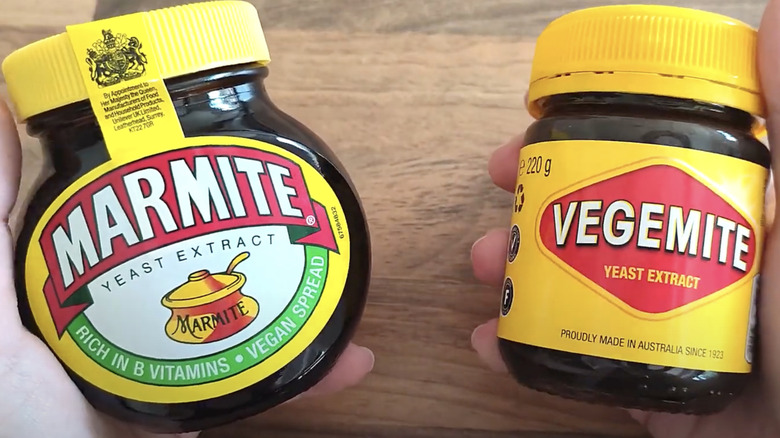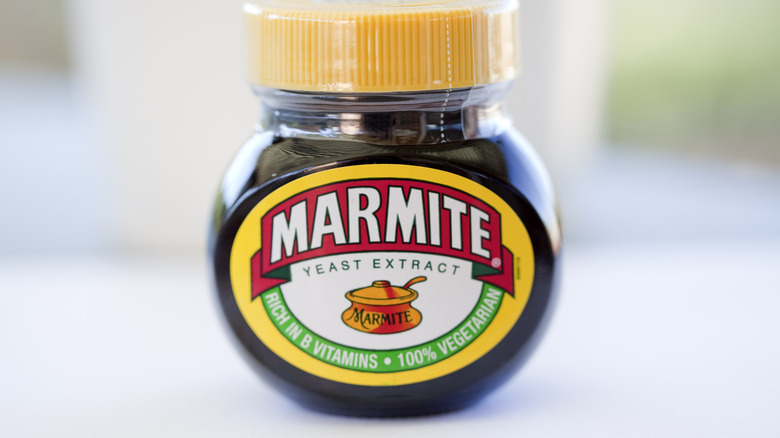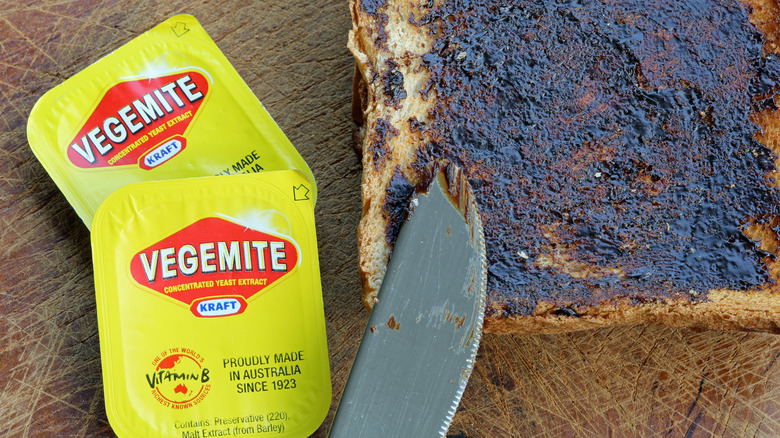The Misunderstood Difference Between Marmite And Vegemite
Marmite and Vegemite are hugely popular spreads from the U.K. and Australia, respectively. Both Marmite and Vegemite are strongly flavored, nutritionally dense yeast spreads made from brewer's yeast extract — a byproduct of brewing beer — and are commonly enjoyed on toast. They both have an acquired taste that can be off-putting to newcomers, yet they are also deeply cherished in their respective countries of origin. The Marmite brand has even capitalized on this divisive reaction by adopting the slogan "Love it or Hate it" for a successful marketing campaign. However, those who overcome the initial shock of the intense flavor often become lifelong fans — for example, both spreads are perfect purchases for anyone looking to build a pantry with umami-rich ingredients.
Marmite and Vegemite are both sold in jars with iconic — and instantly recognizable — yellow lids, and feature high concentration of B vitamins. But while both can be characterized as intensely salty, they differ in texture and taste. Marmite — which was created before Vegemite — has a dark brown hue with a thick, syrupy consistency, and an almost meaty flavor with a hint of sweetness. Vegemite, on the other hand, is a thicker, black paste with a more pronounced yeasty and vegetal flavor, and a touch of bitterness.
Marmite is a salty condiment packed with nutrients
Marmite was invented in 1902 by a German scientist working in the U.K., Justus Freiherr Von Liebig, who also developed the first meat-flavored bouillon cube. When he accidentally discovered that brewer's yeast could be converted into a flavorful and nutritionally beneficial food suitable for vegetarians, Marmite was born. As the scientific understanding of the connection between nutritional deficiencies and disease expanded, Marmite became sought after not only for its flavor but especially for its rich concentration of B vitamins. These vitamins assist in creating red blood cells and bolster various cell functions that contribute to energy production, according to Healthline. Marmite was used as a dietary supplement in schools, hospitals, and by the military during both World Wars. The product's popularity and its cultural impact in Britain have only increased over time.
Owned by Unilever since 2000, the brand now offers an array of Marmite products. A part of the country's cuisine for over a century, Marmite has become an iconic British staple. It is essential on toast but is also incorporated into eggs, mixed into soups, and used as a flavor enhancer for cooking meats and vegetables. Surprisingly, Marmite can even be included in desserts for a unique flavor contrast. Famed English chef Nigella Lawson enjoys using it in spaghetti.
Vegemite spread is for more than just sandwiches
Vegemite was developed in Australia in 1923 as an alternative to the already popular British Marmite, which by that time had gained widespread popularity. Like its precursor, Vegemite was provided to soldiers as part of their rations during World War II. When a shortage of Marmite occurred during the war, Vegemite's rise as Australia's beloved yeast condiment truly began. Although both products share a similar production process and are made from brewer's yeast extract, Vegemite includes additional spices and celery and onion flavorings, making it more savory. The name "Vegemite" reflects the vegetable flavors of these ingredients, which distinguish it from Marmite. It is enjoyed on buttered toast and spreads more like peanut butter than syrup. In Australia, it is also incorporated into baked goods and used as a sandwich filling.
Vegemite's culinary uses are diverse, ranging from gravies and stews to stir-fries, pastas, and even desserts like brownies and salted caramel. For a delectable twist on a classic dish, try using Vegemite as your secret mac and cheese ingredient; it lends the cheesy sauce the perfect umami kick to elevate your macaroni.
While the idea of a salty yeast spread may not seem immediately appetizing, many people can't get enough of it. Expatriates from Australia and the U.K. keep the demand for it alive at specialty shops around the world, all in pursuit of a taste of home.



